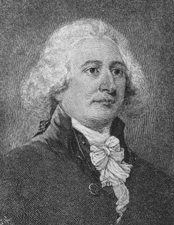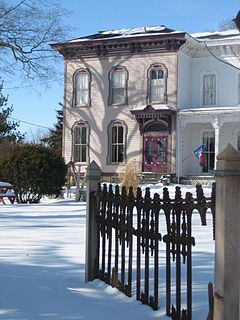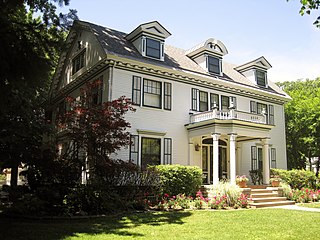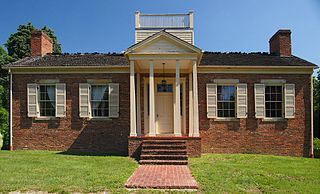
John Pope was a United States Senator from Kentucky, a member of the United States House of Representatives from Kentucky, Secretary of State of Kentucky, and the third Governor of Arkansas Territory.

John Brown was an American lawyer and statesman who participated in the development and formation of the State of Kentucky after the American Revolutionary War.

Archibald Dixon was a U.S. Senator from Kentucky. He represented the Whig Party in both houses of the Kentucky General Assembly, and was elected the 13th Lieutenant Governor of Kentucky in 1844, serving under Governor William Owsley. In 1851, the Whigs nominated him for governor, but he lost to Lazarus W. Powell, his former law partner.

Waveland State Historic Site, also known as the Joseph Bryan House, in Lexington, Kentucky is the site of a Greek Revival home and 10 acres now maintained and operated as part of the Kentucky state park system. It was the home of the Joseph Bryan family, their descendants and the people they enslaved in the nineteenth century. Bryan's father William had befriended Daniel Boone and they migrated west through the Cumberland Gap.

Martin D. Hardin was a politician and lawyer from Kentucky. Born in Pennsylvania, his family immigrated to Kentucky when he was still young. He studied law under George Nicholas and commenced practice at Richmond, Kentucky. His cousin, future U.S. Representative Benjamin Hardin, studied in his law office. He represented Madison County in the Kentucky House of Representatives for a single term.

Richard Henderson was an American jurist, land speculator and politician who was best known for attempting to create the Transylvania Colony in frontier Kentucky. Henderson County and its seat Henderson, Kentucky are named for him. He also sold land to an early settlement that went on to become Nashville, Tennessee.

Richard Hawes Jr. was a United States representative from Kentucky and the second Confederate Governor of Kentucky. He was part of the politically influential Hawes family. His brother, uncle, and cousin also served as U.S. Representatives, and his grandson Harry B. Hawes was a member of the United States Senate. He was a slaveholder.
Central State Hospital is a 192-bed adult psychiatric hospital located in eastern Louisville-Jefferson County, Kentucky. In 1869, 200 acres were purchased by the Kentucky State Legislature from the descendants of renown frontiersman Issac Hite to establish a "State House of Reform for Juvenile Delinquents." This was located on the outskirts of what would become Anchorage, Kentucky. In 1873, due to overcrowding at both of Kentucky's mental hospitals, the House of Reform was converted into the Fourth Kentucky Lunatic Asylum, with Dr. C.C. Forbes as its first Superintendent. The following year an act of the legislature renamed it the Central Kentucky Lunatic Asylum. In late 1887, it received its own post office, called simply "Asylum". The following year its name was changed to "Lakeland", and the institution was commonly referred to as "Lakeland Hospital" or "Lakeland Asylum". By 1900, its official name had been changed to the Central Kentucky Asylum for the Insane. By 1912 it was known as Central State Hospital. Comparable institutions are Eastern State Hospital at Lexington in Fayette County and Western State Hospital at Hopkinsville, Christian County, Kentucky. All three were administered by the Board of Charitable Organizations.

The houses in the Sycamore Historic District, in Sycamore, Illinois, United States, cross a variety of architectural styles and span from the 1830s to the early 20th century. There are 187 contributing properties within the historic district, 75% of the districts buildings. Many of the homes are associated with early Sycamore residents, usually prominent business leaders or politicians. Houses within the district are known by, either their street address or by a name associated with a prominent owner or builder. For most of the houses, the latter is true.

The John Hunt Morgan Memorial in Lexington, Kentucky, is a monument created during the Jim Crow era, as a tribute to Confederate General John Hunt Morgan, who was from Lexington and is buried in Lexington Cemetery. The monument was originally situated on the Courthouse Lawn at the junction of North Upper and East Main Street, but was moved to Lexington Cemetery in 2018.

Lexington, Kentucky was a city of importance during the American Civil War, with notable residents participating on both sides of the conflict. These included John C. Breckinridge, Confederate generals John Hunt Morgan and Basil W. Duke, and the Todd family, who mostly served the Confederacy although one, Mary Todd Lincoln, was the first lady of the United States, wife of President Abraham Lincoln.

The Confederate Memorial in Nicholasville is a historic statue created in the Jim Crow era and located on the Jessamine County courthouse lawn in Nicholasville, Kentucky, ten miles south of Lexington, Kentucky.

Samuel McDowell was a soldier in three wars and political leader in Virginia and Kentucky. He served under George Washington in the French and Indian War, as an aide-de-camp to Isaac Shelby in Lord Dunmore's War, and under Nathanael Greene during the Revolutionary War. He then relocated to Kentucky and became a surveyor. Later, he was appointed one of the first district court judges in what would become the state of Kentucky. He became a leader of the movement to separate Kentucky from Virginia, and presided over nine of the state's ten constitutional conventions. He was the father of Dr. Ephraim McDowell.
Hope Park was an 18th and 19th-century plantation in Fairfax County in the U.S. state of Virginia, where Dr. David Stuart (1753–1814), an old friend of and correspondent with George Washington lived with his wife, Eleanor Calvert Custis (1758–1811), and family. It was approximately 5 miles (8.0 km) southwest of Fairfax Court House.
Thomas Lewis was an American Revolutionary War veteran who figured prominently in the early development of Lexington, Kentucky and the Commonwealth of Kentucky. He administered the oath of office to Kentucky's first governor, Isaac Shelby, in 1792.

The Riverview Historic District is a historic district in Kankakee, Illinois, United States. The 78.2-acre (31.6 ha) area around the Kankakee River is the oldest intact residential neighborhood in the city. It was originally settled by Emory Cobb, who used the land as pasture before deciding to erect a resort hotel. After the hotel burned down, the property was subdivided. The district includes 118 contributing buildings, including two Frank Lloyd Wright houses.

Colonel William Jones House, also known as William Jones State Historic Site, is a historic house in Gentryville and the Lincoln State Park in Jackson Township, Spencer County, Indiana. It was listed on the National Register of Historic Places on May 12, 1975. William Jones (1803–1864) was a farmer, merchant, soldier, and politician.

Robert Smith Todd was an American lawyer, soldier, banker, businessman and politician who was the father of First Lady Mary Todd Lincoln.

The Stow-Hardy House is a historic American Revolutionary War site associated with the revolution's first battle, the 1775 battles of Lexington and Concord. It stands, on the site of a previous home built around 1689, on Lexington Road in Concord, Massachusetts, just southwest of the former Battle Road. It is one of eleven houses within the Minute Man National Historic Park that still exists today.

The Craig House is a restored Revolutionary War era farmhouse. In June 1778, it was used by the British Army as a hospital during the Battle of Monmouth. It is one of many 18th century farmhouses that have been preserved at Monmouth Battlefield State Park. The Craig House is located in Freehold Township in Monmouth County, New Jersey. Monmouth Battlefield is administered by the New Jersey State Park Service.



















